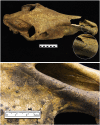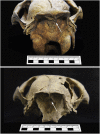Early evidence for mounted horseback riding in northwest China
- PMID: 33139545
- PMCID: PMC7703595
- DOI: 10.1073/pnas.2004360117
Early evidence for mounted horseback riding in northwest China
Abstract
Horseback riding was a transformative force in the ancient world, prompting radical shifts in human mobility, warfare, trade, and interaction. In China, domestic horses laid the foundation for trade, communication, and state infrastructure along the ancient Silk Road, while also stimulating key military, social, and political changes in Chinese society. Nonetheless, the emergence and adoption of mounted horseback riding in China is still poorly understood, particularly due to a lack of direct archaeological data. Here we present a detailed osteological study of eight horse skeletons dated to ca. 350 BCE from the sites of Shirenzigou and Xigou in Xinjiang, northwest China, prior to the formalization of Silk Road trade across this key region. Our analyses reveal characteristic osteological changes associated with equestrian practices on all specimens. Alongside other relevant archaeological evidence, these data provide direct evidence for mounted horseback riding, horse equipment, and mounted archery in northwest China by the late first millennium BCE. Most importantly, our results suggest that this region may have played a crucial role in the spread of equestrian technologies from the Eurasian interior to the settled civilizations of early China, where horses facilitated the rise of the first united Chinese empires and the emergence of transcontinental trade networks.
Keywords: China; Xinjiang; early Iron Age; horseback riding; zooarchaeology.
Conflict of interest statement
The authors declare no competing interest.
Figures








Comment in
-
Cavalry and the Great Walls of China and Mongolia.Proc Natl Acad Sci U S A. 2021 Apr 20;118(16):e2024835118. doi: 10.1073/pnas.2024835118. Proc Natl Acad Sci U S A. 2021. PMID: 33846259 Free PMC article. No abstract available.
Similar articles
-
Tracing horseback riding and transport in the human skeleton.Sci Adv. 2024 Sep 20;10(38):eado9774. doi: 10.1126/sciadv.ado9774. Epub 2024 Sep 20. Sci Adv. 2024. PMID: 39303033 Free PMC article. Review.
-
Pastoral subsistence and mounted fighting in the Eastern Tianshan Mountain region: New insights from the Shirenzigou worked bone assemblage.PLoS One. 2021 Dec 14;16(12):e0259985. doi: 10.1371/journal.pone.0259985. eCollection 2021. PLoS One. 2021. PMID: 34905540 Free PMC article.
-
Origins of equine dentistry.Proc Natl Acad Sci U S A. 2018 Jul 17;115(29):E6707-E6715. doi: 10.1073/pnas.1721189115. Epub 2018 Jul 2. Proc Natl Acad Sci U S A. 2018. PMID: 29967157 Free PMC article.
-
Radiocarbon-dated archaeological record of early first millennium B.C. mounted pastoralists in the Kunlun Mountains, China.Proc Natl Acad Sci U S A. 2011 Sep 20;108(38):15733-8. doi: 10.1073/pnas.1105273108. Epub 2011 Sep 12. Proc Natl Acad Sci U S A. 2011. PMID: 21911387 Free PMC article.
-
Understanding horse domestication and horse health care in the ancient world.J Equine Vet Sci. 2025 May;148:105419. doi: 10.1016/j.jevs.2025.105419. Epub 2025 May 15. J Equine Vet Sci. 2025. PMID: 40382016 Review.
Cited by
-
Cavalry and the Great Walls of China and Mongolia.Proc Natl Acad Sci U S A. 2021 Apr 20;118(16):e2024835118. doi: 10.1073/pnas.2024835118. Proc Natl Acad Sci U S A. 2021. PMID: 33846259 Free PMC article. No abstract available.
-
Tracing horseback riding and transport in the human skeleton.Sci Adv. 2024 Sep 20;10(38):eado9774. doi: 10.1126/sciadv.ado9774. Epub 2024 Sep 20. Sci Adv. 2024. PMID: 39303033 Free PMC article. Review.
-
Pastoral subsistence and mounted fighting in the Eastern Tianshan Mountain region: New insights from the Shirenzigou worked bone assemblage.PLoS One. 2021 Dec 14;16(12):e0259985. doi: 10.1371/journal.pone.0259985. eCollection 2021. PLoS One. 2021. PMID: 34905540 Free PMC article.
-
Rethinking the evidence for early horse domestication at Botai.Sci Rep. 2021 Apr 2;11(1):7440. doi: 10.1038/s41598-021-86832-9. Sci Rep. 2021. PMID: 33811228 Free PMC article.
-
Reply to Shelach-Lavi et al.: Implications of the horse assemblages from Shirenzigou and Xigou.Proc Natl Acad Sci U S A. 2021 Apr 20;118(16):e2025947118. doi: 10.1073/pnas.2025947118. Proc Natl Acad Sci U S A. 2021. PMID: 33846263 Free PMC article. No abstract available.
References
-
- Anthony D. W., The Horse, the Wheel, and Language: How Bronze-Age Riders from the Eurasian Steppes Shaped the Modern World, (Princeton University Press, Princeton, NJ, 2010).
-
- Anthony D. W., Brown D. R., The secondary products revolution, horse-riding, and mounted warfare. J. World Prehist. 24, 131–160 (2011).
-
- Anthony D., Telegin D. Y., Brown D., The origin of horseback riding. Sci. Am. 265, 94–99 (1991).
-
- Kelekna P., The Horse in Human History, (Cambridge University Press, Cambridge, UK, 2009).
-
- Olsen S. L., “Early horse domestication on the Eurasian steppe” in Documenting Domestication: New Genetic and Archaeological Paradigms, Zeder M. A., Bradley D. G., Emshweiller E., Smith B. D., Eds. (University of California Press, Los Angeles, CA, 2006), pp. 245–269.
Publication types
MeSH terms
LinkOut - more resources
Full Text Sources

